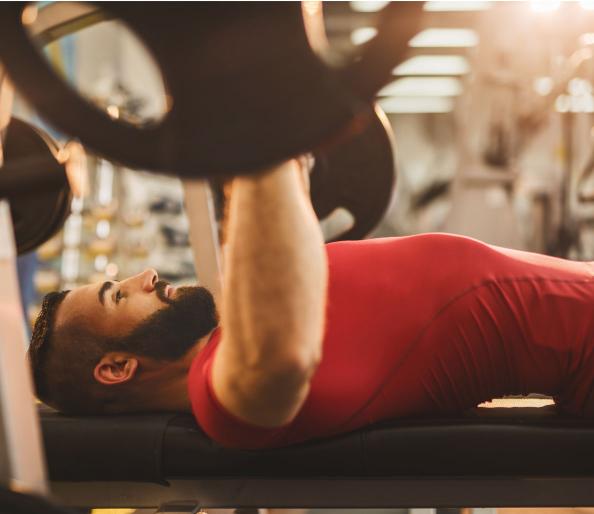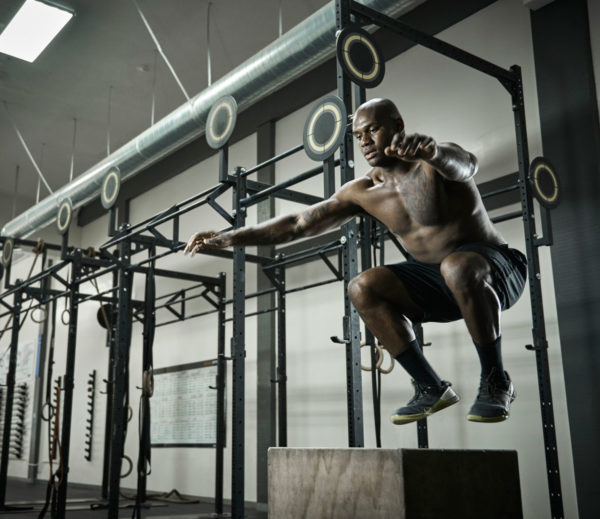Getting strong doesn’t mean loading on the plates as much as possible with every single workout. Moves like that are what get you hurt, and ultimately leave you weaker than before. Stay committed to the gym (or work out at home!) and constantly fine-tune your workouts, and you’re sure to be significantly stronger in a few weeks. But damn it, sometimes that’s just not soon enough — like when you’re meeting your buddies at the gym in an hour, and you want to make sure you smoke them on the bench press. We get it. Here’s how to do it the smart, and safe way:
1. “WORK UP” TO YOUR HEAVIEST WEIGHT INSTEAD OF USING A PYRAMID.
Do several warm-up sets with low reps that prepare you to lift your heaviest on your last few sets. That way, you’ll have energy for those sets — the most crucial ones for strength gains. Say you’re planning to squat with 300 pounds for five reps. You could do 135 pounds for six reps, 185 for five, 225 for three, 275 for two, and then 300 for five. By the time you get to the 300 set, you’ll be thoroughly warmed up but not fatigued.
2. VISUALIZE EVERY REP BEFORE YOU DO THE SET.
Imagine how it will feel, where your eyes will be focused, and how you’ll breathe. Doing so will make you more “familiar” with how the set will be done, and it will seem easier.
3. REST THREE TO FIVE MINUTES BETWEEN SETS.
To lift your hardest, your body needs to regenerate as much ATP — the fuel source for muscle contractions — as possible. Take the time to feel fully recovered before you attempt any personal record on a lift.
4. WORK ON YOUR WEAK POINTS.
If you can’t lock out your elbows on the bench press, try setting the safety rails in a power rack at about your sticking point on the lift. Put roughly 100 pounds more than your one-rep maximum weight on the bar and then try to press it — naturally, you won’t be able to move the bar but try hard anyway for six to 10 seconds. Do four to six reps, resting a few seconds in between, and then lighten the load to the weight you usually have trouble locking out. Your central nervous system should now be sufficiently fired up for you to lift it.
5. TRAIN WITH SOMEONE STRONGER THAN YOU.
Even if you have to invite the biggest animal in the gym to spot you, having someone around who inspires (or intimidates) you will always make you up your intensity.
6. LOAD THE BAR WITH SMALL PLATES.
It makes the bar look lighter. Your brain won’t register it as heavy. That mental advantage can help you lift heavier or do more reps.
7. GO BAREFOOT OR WEAR CONVERSE CHUCK TAYLORS.
The less material there is between your feet and the floor when you lift, the more muscle your body can activate. It’s also better for leverage on moves like the deadlift (you’ll shorten the distance the bar has to travel). If you train at home or in a hardcore gym, lose the shoes. (If your gym requires footwear, thin-soled sneakers like Chucks are ideal.)
8. WARM UP YOUR ROTATOR CUFF BEFORE ANY PRESSING EXERCISE.
Take a two to four-pound medicine ball and push it into a wall with one hand, keeping your arm straight. Roll the ball around on the wall (push hard so it doesn’t slip), tracing the alphabet. Do two sets on each arm, and then do your pressing. Firing up the rotator cuff increases the stability in your shoulders.
9. DO BOX JUMPS IN YOUR WARM-UP FOR LEG DAYS.
Do three sets of three reps, resting 60 seconds between each set. Explosive exercises wake up the central nervous system to recruit maximum muscle.
10. TRY A FEW GLUTE BRIDGES BEFORE DEADLIFTING.
Lie on your back on the floor with your knees bent and feet close to your butt. Dig your heels into the floor and bridge up with your hips, focusing on the contraction in your glutes. Do two sets of eight to 10 reps. Preactivating the glutes — the prime movers in a proper deadlift — allows them to fire at their fullest.
11. SQUEEZE YOUR GLUTES ON EVERY LIFT.
Tightness through your hips leads to increased stability everywhere and will let you put up more weight immediately on any exercise. In other words, you can, in fact, pull a new record “out of your ass.”
12. HOLD ON TO AN ICE PACK FOR ONE TO TWO MINUTES BEFORE LIFTING.
It’s like a cold shower for your nervous system, awakening your senses.
13. USE LIFTING CHALK.
Magnesium carbonate (not the same stuff you used in school to write a sentence 100 times on the blackboard) keeps your hands dry for a superstrong grip. Like the weight belt, it can help you instantly up your max.
14. WARM UP WITH A HEAVIER WEIGHT THAN YOUR WORK SET.
Do your last warm-up set with a heavier weight than what you plan to use in your first work set. Do fewer reps than what you will do on the work set, too. Using the heavier weight in the warm-up will help you recruit extra muscle mass for the work set.
15. WEAR A WEIGHT BELT.
A lifting belt will help support your lower back on deadlifts, squats, and presses. You can increase your max by tens of pounds just by strapping one on.
16. TRY A HOOK GRIP.
Grab the bar overhand as usual but wrap your thumbs around it first. Then wrap your fingers over your thumbs. Reinforcing the thumb with the strength of your other fingers gives you a much better grip. It’s a great way to lift heavier without using straps, which don’t let your grip muscles work hard.
17. PUSH YOUR BELLY OUT DURING A SQUAT OR DEADLIFT.
Take a deep breath from your diaphragm so that your stomach swells outward. (If your shoulders rise, you took the breath into your lungs.) If you’re wearing a weight belt, push your gut into the belt so it feels very tight. Inflating your abdomen increases core stability. Do this on sets of five reps or fewer for an immediate strength increase of at least 10%.
18. GO HEAVY.
Before you curl, load the bar with 20% more weight than what you can lift for five reps. Cheat curl the bar to the top position and hold for two seconds, tensing every muscle. Take four seconds to lower the bar down. Rest one minute, then do your normal set of curls. The load you’re about to lift will feel lighter.
19. WHEN BENCH-PRESSING, DRIVE YOUR HEELS INTO THE FLOOR.
Actively trying to force your body backward on the bench helps turn the lift into a full-body exercise, and it’ll feel easier.
20. IF THE BAR ISN’T COMING UP EVENLY DURING A LIFT…
(as in the bench or shoulder press), or one side begins to sink, squeeze the bar on the lagging side as hard as you can. You’ll send a message to the nervous system, and it will increase strength on that side.
21. DO TWO OR THREE SETS OF THE PLANK AS A WARM-UP.
Get into pushup position and then rest your forearms on the floor. Hold it for 20 to 30 seconds each. You’ll wake up your core, which will better support your lifts.
22. TAKE A DEEP BREATH AFTER YOU LIFT THE BAR OUT OF THE RACK ON A BENCH PRESS.
Now hold it for your first two reps if you can. By not exhaling too soon, you won’t lose your tight position early in the set. This takes a little practice, so avoid it if you’re a beginner.
23. KEEP YOUR WRISTS STRAIGHT DURING A PRESSING LIFT.
The heavier the weight gets, the more you may have a tendency to let your wrists roll back, but don’t. Keeping them straight is a more natural and stable position that will allow you to complete the lift more easily. If you can’t keep them straight, work on your grip strength.
24. PERFORM A “DYNAMIC” WARM-UP INSTEAD OF JOGGING ON A TREADMILL OR PEDALING A BIKE.
Do bodyweight lunges, throwing exercises, or jumps — any movement in which you move your joints through a full range of motion. It will better prepare you to lift than just breaking a sweat with light cardio because it warms your muscles and joints while also prepping the central nervous system to lift heavy.
25. SQUEEZE THE BAR HARD FOR THREE TO FIVE SECONDS.
Let go and rest for three to five seconds, and then begin your set. Squeezing the bar (it also works on dumbbells) forces that tight feeling everywhere in your body and reminds you to stay tight during the lift.
26. PERFORM PARTIAL REPS CORRECTLY.
OK, so you may already do this technique—which involves performing just the top-half of an exercise—but are you using it correctly? The idea of a partial rep is that it allows you to put on more weight than you can normally move (yep, that overload thing again). However, “many people at the gym use this method all of the time because they feel cool lifting a bunch of weight, but it should only be used once or twice a month to help stimulate more muscle fiber recruitment,” says Eric Emig, personal trainer and co-owner of Evolution Fitness, “Abusing this method by doing it all of the time will result in poor flexibility and joint mobility, as well as injured tendons.”
27. FORCE THE NEGATIVE PART OF THE MOVMENT WHERE GAINS IN STRENGTH OCCUR.
For this advanced training technique, you will be deliberately working with more weight than you can actually lift—so get a good spotter, stat! The idea here is to load the body on the lowering portion of an exercise, then get some spotter help to lift it back up. “Everyone has the strength to lower more weight under control than he has to press the weight back up,” Emig says. “And studies have shown that the negative part of the movement is where most gains in strength occur.” More weight than you can lift = overload = strength gains.
28. TRY POWER BANDS OR LIFTING CHAINS.
A.K.A. two ways to make your body work harder on those squats and bench presses. Bands are looped around the end of the barbell and anchored to the floor, while chains are looped but unanchored. “For a bench press, the band has very little tension when the bar is at chest level, but as you extend your arms the variable resistance gets stronger and stronger, which makes the “easiest” part of the lift now very difficult,” Emig explains. “With the chains, as the bar is pressed, more links come up off of the floor, causing a variable resistance that gets stronger at the top of the movement.” The end result: overloading of the muscles, which forces more fibers to fire—and more strength gains for you.
29. GIVE PLYOMETRICS A CHANCE.
You know that plyo is all about channeling and harnessing power. But some current fitness disciplines (rhymes with moss pit) may have you believing that these kinds of explosive moves should be done over and over for many reps on end. The problem with that, though, is that in order to be really explosive, it takes a lot of coordinated muscular effort in every rep—which will without a doubt dissipate the more reps you do. To get the most from plyo, keep your rep schemes in the 5 to 8 range for the big moves (like box jumps), and no more than 12 for the moves that have you reacting or rebounding quickly (like skaters). “Plyometrics are typically associated with jump boxes, but can also be used cautiously bench pressing and squatting,” Emig says.
30. IMPROVE BALANCE WITH SINGLE-LEG DEADLIFTS.
Any time you shift your attention to using one side of your body at a time, it becomes all about balance: First, in the fact that you can distribute equal work to each side—or extra work to your weaker side—to rectify strength imbalances, and second, as with the single-leg deadlift, by actually improving your balance on one foot.
To do: Grasp a pair of dumbbells and hold them by your sides. Shift your weight to one foot and toe the other slightly behind you. With control, hinge at the hips while extending the toed foot up and back behind you and allowing the weights to come down in front of you; Keep your body in one line from head to extended foot and don’t let your chest collapse. Engage the glute and ham of the standing leg to power you back to stand. Do 10 to 15 reps before switching sides.
31. DO MORE STRENGTH-BUILDING WITH SINGLE-ARM PRESSES.
Dumbbell presses—overhead/military and chest—are obviously great for strength building and require more stabilization through the core than barbell presses do. By taking it to one side at a time, you engage the core muscles even more to keep your body balanced. You also can get a greater range of motion, particularly on overhead movements, because you can focus your attention even better on your alignment. More ROM means more muscles are doing the work—and more strength-building.
32. TRY SUITCASE CARRIERS FOR AN OVERALL BETTER POSTURE, CORE, AND GRIP.
It looks so basic—holding heavy weights by your sides and walking—but performing suitcase carries does so many great things for your strength: working your grip, your core, and your posture.
To do: Grab dumbbells that are as heavy as your hands can handle and pace the room till you can’t, or load from one side only and really test your obliques.
33. DO WALL SITS TO HELP YOUR SQUATS AND KNEE PAIN.
Yep, like those one your high school coach made you do during conditioning workouts. “Often neglected because it’s not a ‘sexy’ exercise, wall sits are very effective at building a strong base for squats and mitigating knee pain,” says Josh Holland, NYC-based personal trainer and founder of Zoomtion Fitness.
To do: Plant your feet between hip- and shoulder-width apart, and get your hips down so your knees are at 90 degrees. Try to hold for 2 to 3 minutes or until you can’t take it anymore.
34. IMPROVE YOUR GRIP STRENGTH WITH A SET OF HANGS.
That is, grasping a bar or the top of a door and holding on. “Hanging may seem boring at first but it’s much tougher than people realize,” Holland explains.“It helps in decompressing the joints and improves grip strength when translating to other exercises that require it.”
To do: You can do a dead hang, in which you just, er, hang in there for as long as you can. Or make it more challenging for the lats and shoulders by making it an active hang: pull your shoulder blades down, as if you’re resisting the drop with your armpits. Aim for a minute of each, and also experiment with your grip (overhand, underhand, and neutral with hands facing each other).
35. Create more strength and power in hips with lateral band walks.
A fave of trainers, those mini-banded side steps are excellent for improving hip stability, and in turn protecting the knees from injury. What’s more, by strengthening those side hip muscles, you boost your plyometric power on moves like box jumps. “Creating more strength and power out of the hips is beneficial for both men and women, says Holland.
To do: Wrap a mini-band around both legs, above or below the knees. Maintain a half-squat position, and take a big side-step, followed by a half step with the other foot. Keep going, 20 steps one way, then switch directions. Aim for three sets. Up the challenge by finishing with 20 banded jumping jacks.
36. Complete pallod press reps.
So many “standard” core exercises are all about bending (like crunches and situps) or twisting (like bicycles or Russian twists). These are all well and good, but you’ll really max out your core strength if you also train those muscles to resist those very actions—in other words, to stabilize against the desire to flex or twist. Pallof presses load your core from the side and force it to hold strong.
To do: Adjust the handle of a cable machine to about solar plexus level. Stand so one side of your body faces the machine, and pull the cable in both hands so it’s right in front of you. Keeping your shoulders and hips square, extend both arms straight out, resisting the cable’s load and your body’s desire to give in and twist toward the machine. Hold your arms out from 2 to 10 seconds, then bring your hands back in close to your body. Do 5 to 20 reps. Experiment with the cable weight to increase the challenge.
37. Warm up with Y-T-As to open up chest muscles.
They ain’t glamorous, but they work both your shoulder and core stability while opening up tight chest muscles, all of which can impede range of motion if neglected. Lie face down on the floor, arms extended overhead in a Y shape. Turn your thumbs up and peel your upper body off the floor as high as you can while keeping your head neutral and your toes on the floor. Lower down, and move your arms so they’re straight out in a T position. Repeat the torso-raising. Lower down, then move your arms along your sides in an A position, and lift and lower once more. Repeat from the top for 10 total reps, rest a minute, and do another set. Include in your warmup, especially on shoulder or chest day.
38. Try rotator cuff exercises.
Another from the boring-but-necessary files, shoulder internal and external rotation exercises help to strengthen the rotator cuff muscles, which are small but essential for shoulder stability. More stable shoulders can move more weight. So that you get tension across the full range of motion, use a cable machine or a handled resistance band. Set the equipment at belly-button height and pin a folded towel between your elbow and your side. To do external rotation, stand so the handle is coming across your body with your hand in front of your navel and slowly rotate your hand away from your midline. To do internal rotation, stand so the cable or band is pulling away from your working arm, and rotate your hand in toward your navel. Do 20 reps of each direction on each side, then repeat up to three sets. Add ‘em to your warmup on shoulder and chest day.
39. Work your back with band pull-aparts.
For a better bench, work your back. It my sound counter-intuitive, but the back muscles, particularly the rear delts, must hold tension and keep the shoulder complex stable while your chest and arm muscles press that weight up. Band pull-aparts are one way to work rear shoulder stability, and can be done either as a warmup or in between bench sets as an active rest.
To do: When standing, grasp a band with some tension and simply pull your hands apart so your arms are straight out like a T. Go for 15 to 20 reps or experiment with holding tension for time and releasing.
40. Create fuctional training exercises for your muscles.
Doing a strict split routine is all well and good for hypertrophy, if you’ve got the time and the inclination. But even bodybuilders—the smart ones, anyway—will tell you that at least once a week you should make sure your muscles can work together, too, not just in isolation. Movements like chops, bear crawls, and medicine ball drills aid in muscular synergy as well as mobility, essential for muscle recruitment and range of motion.
41. Complete interval trainings to stay pumped.
Cardio is not the enemy when it comes to muscle gains. Adding it in, in the form of short-burst intervals, is actually a great way to stay lean while pumping up, particularly if you use your bodyweight as resistance.
To do: Design a quick tabata routine (20 seconds on, 10 seconds off) using full-body power moves like burpees, squat jumps, plyo pushups, and split leaps. Do each exercise for a 4-minute bout (eight 20-second/10-second cycles)) before resting briefly (30 to 60 seconds) and doing the next. Twenty minutes (five exercises) and you’re good.
42. Untangle those knots with foam rolling.
Supple muscles move better and are more efficient. When you have knots and “tangled-up” muscle fibers, you can’t get as much strength or power out of them. You also may be more prone to injury, particularly when tight muscles inhibit your range of motion through a strength training exercise. Not only will foam rolling improve all of these aspects, it also aids in recovery, so you’ll be able to lift again sooner. And once you get over the initial, er, discomfort, it can feel pretty great. So take that 5 minutes at the end of your workout to target the most-often tight muscle groups: mid-back, glutes, hams, quads, and calves. Seriously—that’s one minute for the back, plus 30 seconds per side for each of the others. Done and done.
43. Practice yoga to stay fit and zen.
Yeah, it’s a total cheat catch-all for mobility work. What’s great about yoga is that in addition to getting your body to move better and become more flexible—essential for being able to get the full range of motion out of your lifts—it’s also a great body-weight workout and can serve as excellent cross-training. It also trains your body to breathe with the exertion, which is clutch when you’re putting up crazy-heavy loads. Win-win-win.
44. Rest it out.
You’ve heard it before but it bears repeating (in perhaps a slightly different way): Muscles aren’t built in the gym; they’re built in your bed. Taking a rest-and-recovery day is not lazy—it’s essential for rebuilding after all those micro-tears you put into your muscles during an intense workout. Sometimes, that can mean an active recovery or cross-training day where you take it easy, and other times, it can mean steering clear of the gym entirely. And that’s more than OK.








